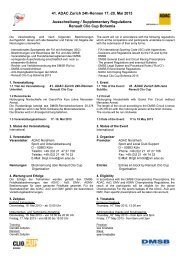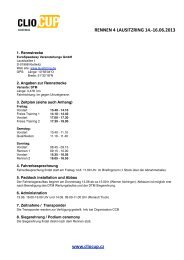Pro praxi - Clio Cup
Pro praxi - Clio Cup
Pro praxi - Clio Cup
You also want an ePaper? Increase the reach of your titles
YUMPU automatically turns print PDFs into web optimized ePapers that Google loves.
Technika<br />
50<br />
bylo 17. místo a řada zkušeností, jež se podařilo zúročit o rok později,<br />
tentokrát ve voze Toyota Supra HV-R. Základem vozu byla Supra GT<br />
pro japonské okruhové mistrovství vybavená dvěma elektromotory<br />
Denso v každém z předních kol a jedním elektromotorem poháně-<br />
jícím zadní nápravu. Vzadu byl také zážehový motor o objemu 4,5<br />
litru. Celkem vůz disponoval výkonem 480 koní dosáhl historicky<br />
prvního vítězství hybridní technologie v motorsportu!<br />
Současný speciál TS030 HYBRID patřící do kategorie LMP1 představila<br />
Toyota v lednu 2012 na francouzském okruhu Paul Ricard.<br />
K pohonu používá zcela nový zážehový motor 3.4 V8/390 kW (530<br />
koní) se čtyřmi ventily na každý válec. Jeho použití bylo jasné.<br />
Možností řešení hybridního pohonu se ale nabízelo více. Zásadní<br />
otázkou byl systém rekuperace energie. Bylo možné použít systém<br />
se speciálním setrvačníkem, nebo využít služeb podobného systému,<br />
jakým je ve formuli 1 KERS s akumulátory. Třetí variantu představovala<br />
aplikace tzv. superkondenzátorů. Murata řešil i další otázku:<br />
umístit elektromotor od společnosti Aisin AW do přední části vozu,<br />
nebo ho integrovat pomocí systému společnosti Denso do pohonu<br />
zadních kol? Nakonec dostaly prostor superkondenzátory Nisshimbo,<br />
které umožňují velmi rychlé absorbování a následné použití<br />
energie (pravidla dovolují 500MJ, po krátkém časovém úseku<br />
rekuperačního brzdění na trati). U případného použití akumulátorů<br />
totiž byla obava z možného přehřívání. Otázka elektromotoru byla<br />
nakonec řešena vestavěním elektromotoru Denso do pohonu zadní<br />
nápravy. Konkrétně došlo k umístění elektromotoru do skříně převodovky,<br />
uložené před zadní nápravou. Důvodem bylo rozložení<br />
hmotnosti a s tím spojené optimální nastavení přítlaku vozu a také<br />
pravidla ACO. Ta totiž v tomto případě umožňují použití hybridního<br />
pohonu v jakémkoliv okamžiku během závodu. Druhé navrhované<br />
řešení s uložením elektromotoru vpředu by totiž umožňovalo použít<br />
hybridní systém pouze v rychlosti nad 120 km/h.<br />
A jak to tedy celé funguje? Automobil při brzdění akumuluje energii<br />
(rekuperační bezdění), kterou dokáže chovávat ve vysokokapa-<br />
Toyota TS030 HYBRID v akci.<br />
The Toyota TS030 in action.<br />
Motorsport-Ing. 2/2012<br />
hybrid prototype Lexus GS 450h with a total output of 345 hp. The<br />
result was the 17th place and a lot of experience that was capitalized<br />
one year later in Toyota Supra HV-R. The car was based on Supra GT<br />
for Japanese championship and equipped with two Denso electric<br />
motors in each of front wheels and a single electric motor driving the<br />
rear axle. The car had also a 4.5 l petrol engine at the rear. The car<br />
developed a total output of 480 hp and achieved the first ever victory<br />
of hybrid technology in history of motorsport!<br />
The present prototype TS030 HYBRID of the LMP1 category was introduced<br />
by Toyota at the French circuit Paul Ricard in January 2012. The<br />
engine is a brand new 3.4 V8/390 kW (530 hp) with four valves per<br />
cylinder. The use of the powertrain was clear however the engineers<br />
were assessing two distinct versions of the hybrid system. The fundamental<br />
issue was the system of mechanical energy recovery. It was<br />
possible to use a special flywheel system or to employ a similar system<br />
like KERS in Formula 1 using batteries. The third option was so-called<br />
supercapacitors. Murata also dealt with another question: whether<br />
to put the electric motor developed by Aisin AW at the front of the car<br />
or to integrate it by means of the Denso system to the rear wheel<br />
drive?<br />
Finally the way was left for Nisshimbo supercapacitors enabling very<br />
fast recovering and subsequent use of energy (regulations allow 500<br />
MJ after a short period of regenerative braking on the track). There<br />
was concern about potential overheating in case of batteries use. The<br />
issue was finally solved by use of the Denso electric motor fitted into<br />
drive of the rear axle. The electric motor was mounted into the gearbox<br />
housing situated in front of the rear axle. The reason was the weight<br />
distribution and the related optimal grip adjustment as well as ACO<br />
regulations. In this case regulations enable use of the hybrid drive at<br />
any time during the race. The second proposed solution, i.e. frontmounted<br />
electric motor would limit the use of the hybrid system only<br />
to speeds exceeding 120 km/h.<br />
And how does it all work? The car recovers energy under braking (re-






